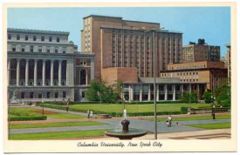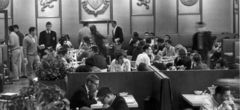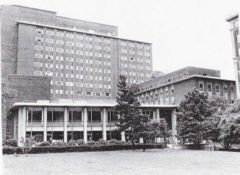Difference between revisions of "Ferris Booth Hall"
Absentminded (talk | contribs) |
|||
| Line 7: | Line 7: | ||
Prior to its construction, various locations around campus served the function of student center, most notably the second floor of [[John Jay Hall]], a space now occupied by [[Health Services]]. | Prior to its construction, various locations around campus served the function of student center, most notably the second floor of [[John Jay Hall]], a space now occupied by [[Health Services]]. | ||
| − | Ferris Booth also featured an outdoor terrace that hosted numerous bands. The Grateful Dead played Ferris Booth following the [[1968 protests]]. | + | Ferris Booth also featured an outdoor terrace that hosted numerous bands. [[w:The Grateful Dead|The Grateful Dead]] played Ferris Booth following the [[1968 protests]].[http://www.gettyimages.com/search/detail.aspx?id=528-248&esource=feed_google_video] |
[[Lerner Hall]] has none of these amenities. Instead, it has ramps. | [[Lerner Hall]] has none of these amenities. Instead, it has ramps. | ||
Revision as of 15:18, 17 March 2008


The predecessor to Alfred Lerner Hall, Ferris Booth Hall (known among students simply as FBH, or in the 90s as FBiatch) boasted magnificent campus views, a grand entry hall staircase, six-lane bowling alley, fifty-foot rifle range, billiards room, and in the Hewitt Lounge, an open-sided fireplace. Completed in 1960 from a design by Shreve, Lamb and Harmon Associates, it was razed in 1996.
Prior to its construction, various locations around campus served the function of student center, most notably the second floor of John Jay Hall, a space now occupied by Health Services.
Ferris Booth also featured an outdoor terrace that hosted numerous bands. The Grateful Dead played Ferris Booth following the 1968 protests.[1]
Lerner Hall has none of these amenities. Instead, it has ramps.
Ferris Booth Commons, a dining facility in Lerner, is named in commemoration of the former centers namesake. A plaque on the walkway outside the glass wall of Lerner also memorializes the old building.
Citizenship Center
University President Eisenhower first proposed, but never seriously pursued, creating a "Citizenship Center" where students would develop "a greater sense of obligation and responsibility to the community". The "Citizenship Center" would be partially staffed by military officers and host a rifle range to teach students how to shoot and kill Communists. As recently as 1960, a rifle range existed under Philosophy Hall. The mission of Columbia's student centers since then has backed off from the second half of Eisenhower's plan, but still tries to uphold the first half, as exemplified in the Double Discovery Center.
